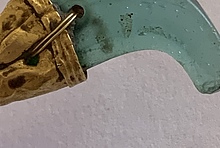Home PageAbout MindatThe Mindat ManualHistory of MindatCopyright StatusWho We AreContact UsAdvertise on Mindat
Donate to MindatCorporate SponsorshipSponsor a PageSponsored PagesMindat AdvertisersAdvertise on Mindat
Learning CenterWhat is a mineral?The most common minerals on earthInformation for EducatorsMindat ArticlesThe ElementsThe Rock H. Currier Digital LibraryGeologic Time
Minerals by PropertiesMinerals by ChemistryAdvanced Locality SearchRandom MineralRandom LocalitySearch by minIDLocalities Near MeSearch ArticlesSearch GlossaryMore Search Options
The Mindat ManualAdd a New PhotoRate PhotosLocality Edit ReportCoordinate Completion ReportAdd Glossary Item
Mining CompaniesStatisticsUsersMineral MuseumsClubs & OrganizationsMineral Shows & EventsThe Mindat DirectoryDevice SettingsThe Mineral Quiz
Photo SearchPhoto GalleriesSearch by ColorNew Photos TodayNew Photos YesterdayMembers' Photo GalleriesPast Photo of the Day GalleryPhotography
╳Discussions
💬 Home🔎 Search📅 LatestGroups
EducationOpen discussion area.Fakes & FraudsOpen discussion area.Field CollectingOpen discussion area.FossilsOpen discussion area.Gems and GemologyOpen discussion area.GeneralOpen discussion area.How to ContributeOpen discussion area.Identity HelpOpen discussion area.Improving Mindat.orgOpen discussion area.LocalitiesOpen discussion area.Lost and Stolen SpecimensOpen discussion area.MarketplaceOpen discussion area.MeteoritesOpen discussion area.Mindat ProductsOpen discussion area.Mineral ExchangesOpen discussion area.Mineral PhotographyOpen discussion area.Mineral ShowsOpen discussion area.Mineralogical ClassificationOpen discussion area.Mineralogy CourseOpen discussion area.MineralsOpen discussion area.Minerals and MuseumsOpen discussion area.PhotosOpen discussion area.Techniques for CollectorsOpen discussion area.The Rock H. Currier Digital LibraryOpen discussion area.UV MineralsOpen discussion area.Recent Images in Discussions
Identity HelpWulfenite possible location required pls.

23rd Nov 2019 03:55 UTCGreg Dainty
23rd Nov 2019 04:11 UTCKeith Compton 🌟 Manager
Looks Moroccoan to me
Cheers
23rd Nov 2019 07:59 UTCJolyon Ralph Founder

23rd Nov 2019 08:42 UTCJohn Sobolewski 🌟 Expert
23rd Nov 2019 08:44 UTCKeith Compton 🌟 Manager
Given it's from an old Australian collection, there were a number of Aussie dealers that had Moroccoan Wulfenites back in the early 1980s (Touissit-Bou Beker district).
And yes, Mexico has produced similar.
23rd Nov 2019 13:27 UTCJohan Kjellman Expert

23rd Nov 2019 18:58 UTCFrancis X Dzubeck
By any chance do you have a date when the specimen entered the collection? Reason being, if it was in he 1980's, it would have been labeled "Putis IX Mine" or just "Touisst." They were first brought out by Victor Yount in 1982. Them an mass in the latter 1980's by Moroccan/European dealers. The date will tel the story. If it entered the collection latter in the 1990's -2000's it could be from Mexico at a locality called the "Mitchell Prospect in Mun. de Rayon, Sonora. Wulfenite similar to your specimen came into the Market at the Tucson Show during that time period.
Frank

23rd Nov 2019 23:50 UTCGreg Dainty
Yes I think Morocco is most likely the origin of the specimen. Thanks everybody for their help, particularly Franks detailed reply. Frank the origin of the specimen is almost certainly the very early 1980s, as the collection has been in storage since then. There were also a number of other early 1980s specimen in the collection. Including this greenish yellow anglesite, pictured.
I do remember that some Moroccan anglesites had been treated to give color, I was wondering if anybody could advise me if this may have been the case with the pictured specimen? Again thank you everybody for your replies, very appreciated.
24th Nov 2019 00:24 UTCJohan Kjellman Expert
And it is "Puit IX", i.e. pit/adit no. 9.

24th Nov 2019 14:03 UTCErik Vercammen Expert

24th Nov 2019 17:04 UTCFrancis X Dzubeck
The Anglesites of this type all come out at the same time as the Wulfenites and the yellow-green type were alwat=ys in a Galena matrix. The off matrix ones were lager perfect crystals. In actuality the treated ones were of a clear Amber color and tended to be larger crystals to make greater profit. I never did see a red Anglesite in the 1980's. Also, I agree with Erik. I tend to use the labeling language that was provided with the specimen. In the 1980's all Morocan martial had a locality label in French and as I said before, had only two localities - Putis IX or Touisst!
Frank
24th Nov 2019 17:33 UTCJohan Kjellman Expert
Wulfenites were most frequently quoted as comming from Zelidja or Bou Beker, whereas for anglesite the locality was usually stated Touissit.
This link provides data on the district and the sublocalities:
26th Nov 2019 14:46 UTCUwe Kolitsch Manager
> And it is "Puit IX", i.e. pit/adit no. 9.




Mindat.org is an outreach project of the Hudson Institute of Mineralogy, a 501(c)(3) not-for-profit organization.
Copyright © mindat.org and the Hudson Institute of Mineralogy 1993-2024, except where stated. Most political location boundaries are © OpenStreetMap contributors. Mindat.org relies on the contributions of thousands of members and supporters. Founded in 2000 by Jolyon Ralph.
Privacy Policy - Terms & Conditions - Contact Us / DMCA issues - Report a bug/vulnerability Current server date and time: May 14, 2024 13:58:49
Copyright © mindat.org and the Hudson Institute of Mineralogy 1993-2024, except where stated. Most political location boundaries are © OpenStreetMap contributors. Mindat.org relies on the contributions of thousands of members and supporters. Founded in 2000 by Jolyon Ralph.
Privacy Policy - Terms & Conditions - Contact Us / DMCA issues - Report a bug/vulnerability Current server date and time: May 14, 2024 13:58:49












